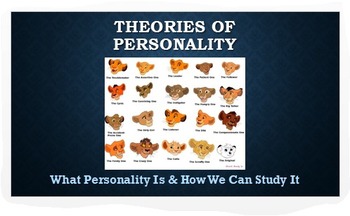Psychology: Personality Theory PPT ~ Psychoanalysis, Behaviorism, Humanism
Engaging Language Arts and Psychology
188 Followers
Grade Levels
9th - 12th, Higher Education, Adult Education, Homeschool
Subjects
Resource Type
Standards
CCSSCCRA.SL.1
CCSSCCRA.SL.2
CCSSCCRA.SL.4
CCSSCCRA.SL.6
CCSSRST.9-10.1
Formats Included
- PPTX
Pages
49 pages
Engaging Language Arts and Psychology
188 Followers
Description
Introductory PowerPoint for a Personality unit in Psychology course. Highly detailed, graphic and accurate 49-slide 2013 presentation and introduction to the following seven theories on personality development: Freudian Psychoanalytic theory; Behaviorism; Humanism; Trait Theory; BioPsychological theory; Evolutionary Psychology theory; Type Theory.
With this extensive 49-slide, at least 2 full class periods presentation, you get:
a.) Learning Targets
b.) Highly detailed, accurate information presented on each of the above theories
c.) Background as to why we study personality
d.) Relevant examples with the theories
e.) Major psychologists detailed (including Freud, Jung, Maslow, Rogers, Skinner, Allport, Eysenck, Cattell, TAT and Rorschach testing, Darwin, etcetera!)
f.) Hyperlinks to personality tests (MBTI), video links (eg. Phineas Gage w/BioPsych theory), etc. for further explication to be viewed or skipped at your discretion
g.) Custom transitions between slides
h.) Custom animations within slides
i.) An engaging culminating writing/partner activity for student application and analysis, moving forward in the unit
I appreciate your business and look forward to your feedback. Enjoy! Thank you for checking out my store!
With this extensive 49-slide, at least 2 full class periods presentation, you get:
a.) Learning Targets
b.) Highly detailed, accurate information presented on each of the above theories
c.) Background as to why we study personality
d.) Relevant examples with the theories
e.) Major psychologists detailed (including Freud, Jung, Maslow, Rogers, Skinner, Allport, Eysenck, Cattell, TAT and Rorschach testing, Darwin, etcetera!)
f.) Hyperlinks to personality tests (MBTI), video links (eg. Phineas Gage w/BioPsych theory), etc. for further explication to be viewed or skipped at your discretion
g.) Custom transitions between slides
h.) Custom animations within slides
i.) An engaging culminating writing/partner activity for student application and analysis, moving forward in the unit
I appreciate your business and look forward to your feedback. Enjoy! Thank you for checking out my store!
Total Pages
49 pages
Answer Key
Does not apply
Teaching Duration
2 days
Report this resource to TPT
Reported resources will be reviewed by our team. Report this resource to let us know if this resource violates TPT’s content guidelines.
Standards
to see state-specific standards (only available in the US).
CCSSCCRA.SL.1
Prepare for and participate effectively in a range of conversations and collaborations with diverse partners, building on others’ ideas and expressing their own clearly and persuasively.
CCSSCCRA.SL.2
Integrate and evaluate information presented in diverse media and formats, including visually, quantitatively, and orally.
CCSSCCRA.SL.4
Present information, findings, and supporting evidence such that listeners can follow the line of reasoning and the organization, development, and style are appropriate to task, purpose, and audience.
CCSSCCRA.SL.6
Adapt speech to a variety of contexts and communicative tasks, demonstrating command of formal English when indicated or appropriate.
CCSSRST.9-10.1
Cite specific textual evidence to support analysis of science and technical texts, attending to the precise details of explanations or descriptions.





